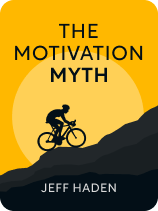

This article is an excerpt from the Shortform book guide to "The Motivation Myth" by Jeff Haden. Shortform has the world's best summaries and analyses of books you should be reading.
Like this article? Sign up for a free trial here.
How do you create a cycle of motivation? Why is repetition helpful for encouragement?
According to Jeff Haden’s book The Motivation Myth, motivation is the momentum that keeps your program of improvement moving forward through a repeating, self-energizing cycle. He further talks about how that cycle works and how it provides you with steady feedback.
Let’s look at how to create a cycle of motivation to keep the momentum going.
Repetition Is the Key to Achievement
The path to achievement is a slow and steady process that requires putting your nose to the grindstone and doing the work, day after day. That’s disheartening if you’re focused on your goal, such as getting a million YouTube subscribers or growing the prettiest garden on your street, because especially in the early days, your goal will seem a million miles away. Instead, you should focus on individual steps, celebrating each bit of incremental progress. Haden writes that every small victory triggers a response in your brain’s reward center that sets up a positive cycle of motivation, which will push you to take the next step, and the next. There’s the motivation you’ve been lacking—not at the start of the process, but in the middle.
(Shortform note: Haden’s advice works because your brain’s reward system is triggered by positive progress, but what if your goal requires not taking an action, such as avoiding snacks to lose weight? In Atomic Habits, James Clear addresses this problem by stating that if your goals require a program of avoidance, you have to create an associated reward for when you successfully fight the urge to crack open a bag of potato chips, for example. Clear writes that whatever reward you give yourself must be associated with the goal you’re trying to reach. In the snacking example, your reward might be a healthy, five-minute walk around the block.)
And now a word of caution: Hard work and repetition don’t guarantee success, but they do improve your probability of success. More than that, Haden explains that if you stick with your program long enough, you’ll be able to calculate the odds of your efforts paying off in a way that will tell you how much work you have left to do. For example, if you’ve been job-hunting for some time, you may find that one in every ten applications results in a call-back from a potential employer. Therefore, if you’d like a call-back every day, that tells you how many jobs to apply for. Random chance is still a factor, but if you act as if your success is completely under your control, you can minimize your reliance on luck just through simple mathematics.
(Shortform note: One way to put yourself in the mindset Haden advises is to model your thoughts and behavior as if you’ve already achieved your goal. In The Success Principles, Jack Canfield suggests you imagine how your life will be different once you achieve your ambitions. Perhaps you’d be more self-confident and comfortable with taking risks. Canfield argues that envisioning or even role-playing your future success can influence your behavior in ways that can bring your goals to fruition. Though this goes against Haden’s cautionary advice not to celebrate your end goal too soon, Canfield presents anecdotal evidence of people who shaped their future success by acting as if they’d achieved it in the present.)
The Feedback Cycle
Repetition is also important for providing you with quick and accurate feedback. For one thing, you’ll certainly make mistakes, each of which is a learning experience. The more you repeatedly push toward your goal, the more mistakes you’ll make and the more you’ll improve. Of course, this requires keeping the proper attitude—view mistakes as training, not a sign of failure. They’ll also teach you how to adjust your efforts. Perhaps you set your daily goals too high or too low and your program needs refinement. Just make sure to evaluate your progress and setbacks in relation to your daily objectives and not your end goal, which may still be months or years away.

———End of Preview———
Like what you just read? Read the rest of the world's best book summary and analysis of Jeff Haden's "The Motivation Myth" at Shortform.
Here's what you'll find in our full The Motivation Myth summary:
- Why you should stop waiting for motivation to hit and instead, make your own
- How to create a cycle of positive reinforcement to boost your motivation
- How to develop resilience to get through times of struggle






